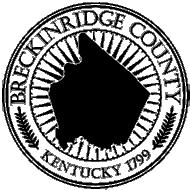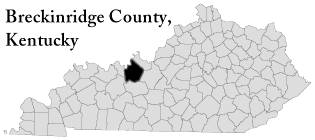 |
USGenWeb Archives Project Breckinridge County, Kentucky |
 |
 |
 |
 |
 |
USGenWeb Archives Project Breckinridge County, Kentucky |
 |
 |
 |
 |
THESE
ARCHIVES BUILT BY YOUR
CONTRIBUTIONS.
PLEASE CONTRIBUTE TODAY!
New
Easy to use Submission
Forms!
This Page Updated Monday, 11-Apr-2022 20:27:52 EDT
| BRECKINRIDGE COUNTY, KENTUCKY |
| AREA COMMUNTIES OF THE PAST AND PRESENT |
| SAMPLE AND UNION STAR |
The first white man to set foot upon Breckinridge County
soil was
at Sample. Colonel
Hardin and his party of settlers
landed in Sample at the falls of Sinking Creek in 1780.
Sample
is antique little community within itself, lying mostly in the
little valley
of Sinking Creek. Mystic
is up the railroad tracks about
four miles at the head of Dry Valley.
Union Star is about
four miles
north east of Sample on the road from Stephensport to Webster.
Union Star was settled in 1809. Lieutenant Adam Barr was
one of
the earliest settlers in this section of the county.
He
was an officer in the Revolutionary War.
Mr. Barr was born
in Virginia in 1757, and moved to Breckinridge County soon after
the
war was over.
Adam Barr was with William Hardin when he went with eighty
men to
dislodge the Indians in the Saline Creek section
of Illinois. This
was only a short distance below
Evansville, Indiana.
He bought a large tract of land at the head of Sugar Tree
Run
between Union Star and Mystic. His
oldest son,
Adam, Jr., along with Peter Cashman were in the War of 1812.
They traveled to New Orleans and fought with Andrew
Jackson in
the Battle of New Orleans. After
the war was over they
walked all the way back to Union Star.
Joseph Allen fought in the War of Independence with Adam
Barr and
came with him to Kentucky.
The Joseph Allen family settled in this county in 1799. More
will be said about Joseph and John Allen later.
Union Star, like all the rest of the frontier communities,
gave
early attention to their religious and education well-being.
The first few years of the settlement found its people
primarily
interested in staying alive and clearing the forest and building
homes.
In the year 1845, Thomas D. Helm donated a plot of land in
Union
Star, upon which to build a school house and a church.
The first school house was built out of logs. Several years
later a new and larger school was built on the same ground.
This one was a
frame building with weather-board siding.
This old school building may be seen there today even
though it
is
slightly dilapidated.
In 1848, Mr. Ed McGlotham left a sum of money in a trust
fund for
the school. The
interest amounted to $100.00
per year, which was used to hire a teacher for two extra months.
This made Union Star the only nine-month school in the
county and
apparently it paid off. Mr.
Horace McCoy taught there for
six years, from 1911 to 1916. In
his 1916 class, he had
forty-two
students. Ten of
these became school teachers. These
were Gertie Barger, Grace McCoy, Ruellma Dowell, Ernest Hesler,
Goldie Stewart, Ora Kellems, Ruth Wagner, Katherine Curry, Ruby
Dowell, and Orville McCoy.
During the spring term many of the more
educationally-minded
students from the neighboring schools would enroll after their
schools were closed. One
such student was Sherman
Beauchamp, who lived at Sample.
I chose him because he is well known and admired in every
crack
and crevice of the county.
He is the Chief
Maintenance man for the County School System.
In any school
or bus route in the county, Beauchamp may be seen within minutes
following any type of mechanical breakdown.
During the Depression of the Thirties, the money left the
school
by Mr. McGlotham was lost when the bank failed, and the
Union Star school was forced to return to its seven-month term.
The last classes were held in this old school in 1945, at
which
time the new consolidated Miliner School was erected at the
Cross Roads.
The Union Star Methodist Church was organized about the
same
time, and services are still being held there.
In 1887, when the railroad came through the north end of
our
county, it completely revolutionized the community.
Up
until this time all produce was hauled to Stephensport to be
shipped to market by river. With
the coming of the
railroad, a store was
established at Sample. This
little community soon
established a unique reputation, something akin to Las Vegas.
There was a
race track, the remains of which may still be seen.
It was
about one half mile north of Sample.
There is a ten or fifteen-acre field that is level, with
the land
rising sharply around three sides forming a perfect and natural
stadium. The hills
surrounding the field or race track was
heavily wooded, making it ideal for spectators.
Camp Ground
Hollow lies at the end toward Sample.
This is so named
because it was used for camping by those staying at the races.
In the earlier days of Sample following the coming of the
railroad, it was probably more widely known for its chicken
fights.
Cock pits were
arranged at different places from Pierce, a
little station about two miles above Sample, to Hog Pen Hollow,
on Shot
Pouch Creek. Shot
Pouch Creek intersects with Sinking Creek
just below the falls.
Sample went by the name of Chicken Bristle for several
years.
It was so named by the railroad men because of the
chickens that were brought there to the fights.
In the latter part of the eighteen hundreds, people came
from
Louisville, Cincinnati, Owensboro, Evansville, and St. Louis,
to fight roosters here.
Mr. Bud Beauchamp, who lives at the junction of Dry Valley
and
Sugar Tree Run, tells of having seen many of the fights with
his father, John W. Beauchamp.
W. K. Riley, Cam Riley, Kerry Applegate, and Mr. Pegturl
from
Owensboro were frequent visitors.
Mr. Bill Hook, Finley Miller, John Beauchamp and others
from
Breckinridge County, had some of the best fighting chickens
in the United States.
Old Yellow Legs, raised by Bud Beauchamp, was about as
famous in
the cock fighting world, as was Man O War in the
race horse world. Old
Yellow Legs was a cross between a
Blue Naragansett Hen and a Red English Cock.
Yellow Legs
was abnormally large, weighing 8 ½ pounds and was a deep red
with long yellow legs. Mr.
Bud Beauchamp trained him by
throwing
him down hard on his feet on the ground or against a wall, where
he would land on his feet and strengthen his legs.
Yellow
Legs was
too big to be in most paired fights, so he was usually in
shakebag matches. Old
Yellow Legs fought in Chicken
Bristle, Louisville,
Cincinnati, Evansville, Owensboro, Canelton, and St. Louis
without losing a fight.
A lot of big money came and went from Sample. At both the
race track and the cock pits there were some
“jim-dandy”
crap games.
The quality of character of the men who frequented this
little
sporting world was superb. Never
was there record of
any violence or ungentlemanly behavior.